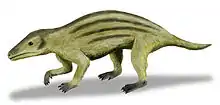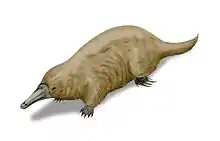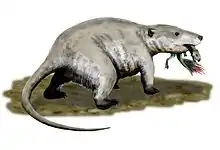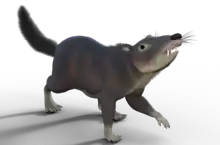Paritatodon
Paritatodon is an extinct mammal which existed in Kyrgyzstan and England during the Jurassic period.[1] It was originally the holotype specimen of Shuotherium kermacki, but Martin and Averianov (2010)[1] argued that it resembled the genus Itatodon (Docodonta) and so renamed it Paritatodon.
| Paritatodon | |
|---|---|
| Scientific classification | |
| Kingdom: | Animalia |
| Phylum: | Chordata |
| Class: | Mammalia |
| Family: | †Shuotheriidae |
| Genus: | †Paritatodon Martin & Averianov, 2010 |
| Species: | †P. kermacki |
| Binomial name | |
| †Paritatodon kermacki (Sigogneau-Russell, 1998) | |
Nonetheless, recent phylogenetic studies assign it (and Itatodon) to Shuotheriidae.[2]
Like many Mesozoic mammals, this species is only known from its teeth, in this case two lower molars from the Forest Marble Formation in England,[3] and a single left lower molar from the Balabansai Formation in the Fergana Depression, Kyrgyzstan.[1]
References
- Thomas Martin & Alexander O. Averianov (2010). "Mammals from the Middle Jurassic Balbanasi Formation of the Fergana Depression, Kyrgyzstan". Journal of Vertebrate Paleontology. 30 (3): 855–871. doi:10.1080/02724631003758045.
- Wang, Y.-Q. and Li, C.-K. 2016. Reconsideration of the systematic position of the Middle Jurassic mammaliaforms Itatodon and Paritatodon. Palaeontologia Polonica 67, 249–256.
- Denise Sigogneau-Russell (1998). "Discovery of a Late Jurassic Chinese mammal in the Upper Bathonian of England". Comptes Rendus de l'Académie des Sciences. 327: 571–576. doi:10.1016/s1251-8050(99)80040-8.
This article is issued from Wikipedia. The text is licensed under Creative Commons - Attribution - Sharealike. Additional terms may apply for the media files.





